Intel Core i7-4790, i5-4690, i5-4590, i5-4460, i3-4360, i3-4350 and i3-4150 Review

Intel has updated the list of their Haswell processors. Instead of the old parts it will be offer a new – with slightly increased model numbers and higher frequencies. Does this change deserve our attention? We have tried to understand in this review.
It has become a kind of tradition for Intel to update its desktop CPU microarchitecture on a yearly basis. The Sandy Bridge was released in early 2011 and followed by the Ivy Bridge in April, 2012. The latest Haswell microarchitecture was introduced on the 4th of June, 2013. Having got used to this regularity, the market is already waiting for the new generation of processors which are known under the codename of Broadwell. However, Intel had some problems transitioning to the new 14nm tech process which was supposed to be used for the Broadwell. That’s why the release date, which had been originally set in the middle of this year, had to be revised. As far as we know at the moment, energy-efficient Broadwell processors for mobile gadgets are going to be announced at the end of 2014 whereas full-featured Broadwell products for desktop and mobile PCs will only become available in 2015.
To fill in the tedious wait, Intel has come up with an idea called Haswell Refresh. Instead of launching completely new Broadwell processors, the company offers improved versions of its older products. They feature the same microarchitecture but have higher clock rates. After the official announcement recently, Intel’s price list has grown by 42 new positions, 24 of which are desktop processors of various classes. In our today’s review we are going to take a look at Haswell Refresh products of the Core i7, i5 and i3 series targeted at ordinary desktop PCs.
Haswell Refresh for Desktop PCs
Haswell Refresh actually means higher clock rates for Intel’s Haswell-based LGA1150 processors. There’s nothing particularly surprising about this idea as the company used to steadily increase its CPU clock rates in between microarchitecture updates in the past. The Haswell Refresh initiative is only different in that the clock rate is increased not for select processor models but for the entire product range.
Intel seems to generate much hype about Haswell Refresh to create an impression of ongoing innovations even though the Broadwell announcement is postponed. We don’t see anything extraordinary about the Haswell Refresh processors just because they are the same Haswell-based products that have been around for about a year but now have a 100MHz higher clock rate. This higher clock rate translates into a performance gain of a mere 2 or 3%.
Fortunately, this small advantage in performance comes at no expense for the buyer. The new Haswell Refresh processors just replace their Haswell predecessors in Intel’s price list in the way shown in the next table (for the desktop models):

It must be noted that the higher clock rate doesn’t change the processors’ TDP, which is set at 84 watts for the Core i7 and i5 and at 54 watts for the Core i3 series. The Haswell Refresh products using the same semiconductor dies as before, the increased frequency potential is ensured by improvements in Intel’s 22nm tech process. The core revision is not changed, so it is still C0. It means we can’t expect any dramatic improvements in terms of thermal or electrical or any other properties of the refreshed processors.
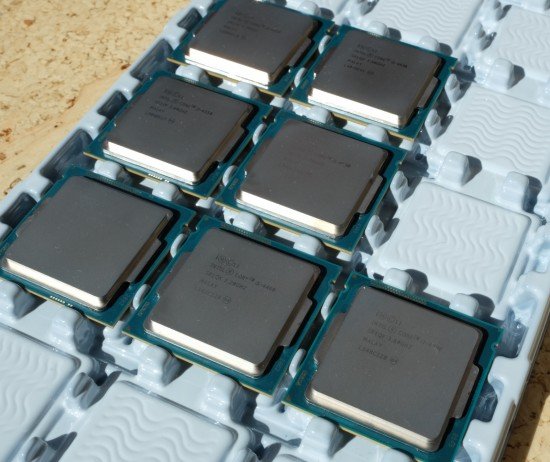
The Haswell Refresh products look exactly like their predecessors:
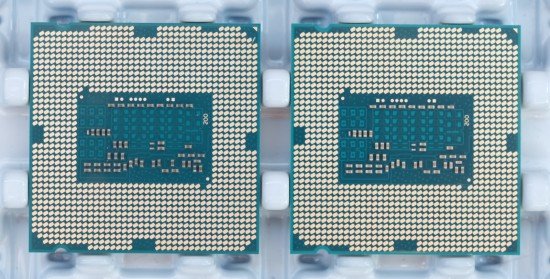
The only difference concerns the overclocker-friendly K series which is going to be announced later, supposedly on June 2. Until then Intel suggests that overclockers use the old Core i7-4770K and Core i5-4670K but we guess we should say a few words about their upcoming replacement.
Haswell Refresh processors with unlocked frequency multipliers, known under the generic codename of Devil’s Canyon, offer something more besides higher default clock rates. Intel wants to make them better for overclocking by changing their packaging. The heat-conductive material between the CPU die and the heat-spreading cap will be replaced with a more efficient one while the cap itself will be made out of a different alloy with better heat conductivity. As far as we know, the Devil’s Canyon will include two unlocked LGA1150 processors: Core i7-4790K and Core i5-4690K. They will have a higher TDP than regular Haswell Refresh products and their default clock rates will be set higher, too.
That’s all we know about the Devil’s Canyon as yet but we hope to test them as soon as they come out. Today we will talk only about regular desktop Haswell Refresh products with standard TDPs. You can already buy such processors in any store.
There is only one new product in the Core i7 series:
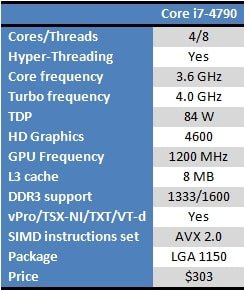
The Core i7-4790 steps up the clock rate of the senior LGA1150 processor series by 100 MHz, being faster than the overclocker-friendly i7-4770K and the regular i7-4771. Otherwise, it is a typical Haswell-based Core i7 with four cores, Hyper-Threading, and a large 8MB L3 cache. The integrated graphics core GT2 incorporates 20 execution devices. Thanks to Turbo Boost 2.0, the Core i7-4790 works at 3.8 GHz most of the time.
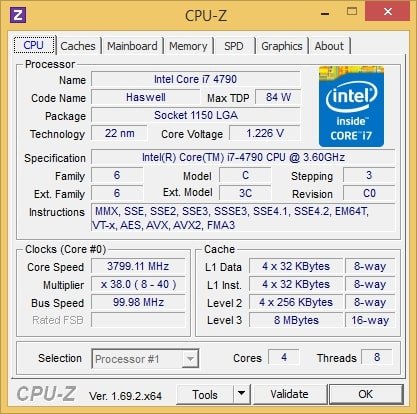
The processor supports the full set of security technologies including vPro, TXT and VT-d. Thus, the Core i7-4790 is the new flagship for the LGA1150 platform but without support for overclocking.
The Core i5 series includes three Haswell Refresh products:
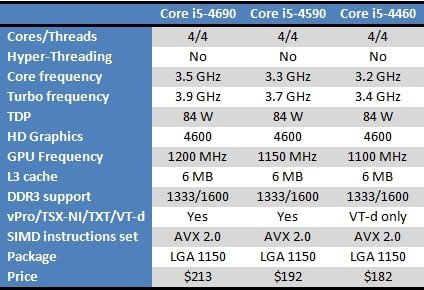
Their clock rates are a mere 100 MHz higher compared to their predecessors, but that’s enough for the Core i5-4690 to surpass the Core i5-4670K and become the fastest model in the Core i5 series. The other models fill in previously unoccupied frequency slots. The rest of their specs have not changed. Hyper-Threading is not supported by any Core i5. The L3 cache is 6 megabytes large and the graphics core is of the GT2 class.
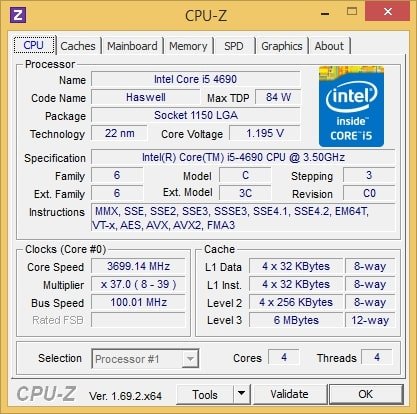
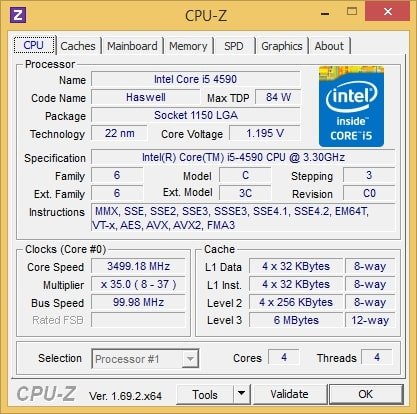
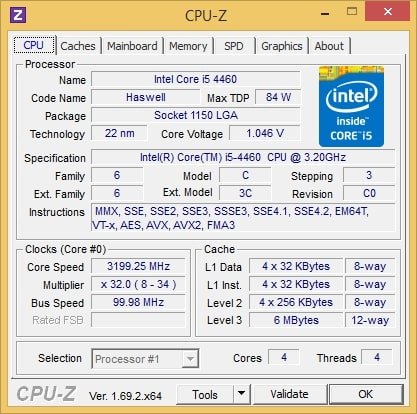
The junior model i5-4460 is special as it doesn’t support vPro and TXT. It can’t work with transactional memory, either. With Turbo Boost 2.0, the typical clock rate of the i5-4690, i5-4590 and i5-4460 is 3.7, 3.5 and 3.2 GHz, respectively.
There are three Haswell Refresh products in the Core i3 series:
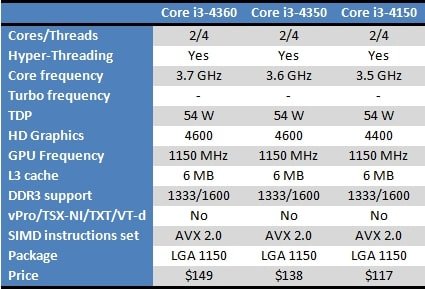
Again, the clock rates are increased by 100 MHz while the rest of the specs are the same as before. Unlike the other series, the Core i3 includes only dual-core processors but with Hyper-Threading support. Thanks to that, their TDP is specified at 54 rather than 84 watts. There were no free frequency slots in the Core i3 series when the Haswell Refresh models were announced, so the Core i3-4350 has exactly the same specs as the Core i3-4340 but comes at a lower price.
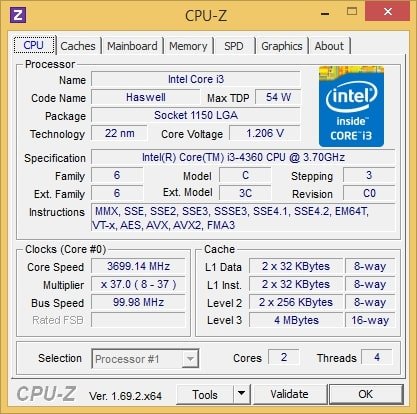
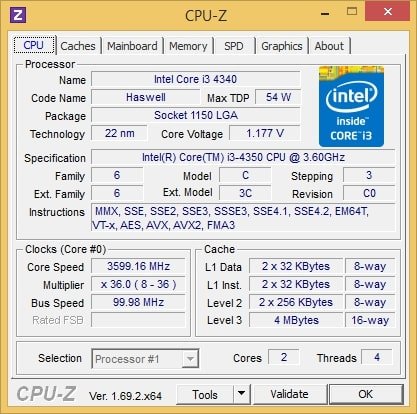
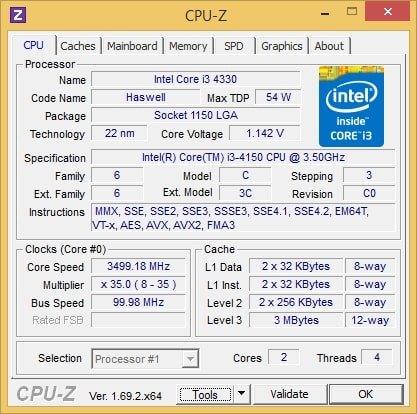
The L3 cache is 4 megabytes large in the i3-4360 and i3-4350 models. The i3-4150 has 3 megabytes of L3 cache memory. Besides, the junior model has a weaker graphic core. Although formally classified as GT2, the i3-4150’s graphics has 16 instead of 20 execution devices.
The LGA1150 Haswell Refresh processors don’t have any special requirements concerning the mainboard. Although their release coincides with the transition to the new 9 series chipsets (Z97 and H97), all of the new CPUs are compatible with LGA1150 mainboards based on Intel’s 8 series chipsets. For the processor to be correctly identified by the mainboard you only need to update the latter’s BIOS.
As for overclocking capabilities, the currently available Haswell Refresh CPUs have none. You can’t increase their clock rate above the default level by changing their frequency multiplier. The base clock rate can be increased to 105-110 MHz but that can hardly be called serious overclocking. On the other hand, these processors allow overclocking system memory up to DDR3-2400.
Testbed and Methods
We will compare the Haswell Refresh processors with their Haswell predecessors which have been selling for almost a year already. Below is the full list of hardware components we will use in this test session.
- Processors:
- Intel Core i7-4790 (Haswell, 4 cores + HT, 3.6-4.0 GHz, 4x256KB L2, 8MB L3)
- Intel Core i7-4770K (Haswell, 4 cores + HT, 3.5-3.9 GHz, 4x256KB L2, 8MB L3)
- Intel Core i5-4690 (Haswell, 4 cores, 3.5-3.9 GHz, 4x256KB L2, 6MB L3)
- Intel Core i5-4670K (Haswell, 4 cores, 3.4-3.8 GHz, 4x256KB L2, 6MB L3)/li>
- Intel Core i5-4590 (Haswell, 4 cores, 3.3-3.7 GHz, 4x256KB L2, 6MB L3)
- Intel Core i5-4570 (Haswell, 4 cores, 3.2-3.6 GHz, 4x256KB L2, 6MB L3)
- Intel Core i5-4460 (Haswell, 4 cores, 3.2-3.4 GHz, 4x256KB L2, 6MB L3)
- Intel Core i5-4440 (Haswell, 4 cores, 3.1-3.3 GHz, 4x256KB L2, 6MB L3)
- Intel Core i3-4360 (Haswell, 2 cores + HT, 3.7 GHz, 2x256KB L2, 4MB L3)
- Intel Core i3-4350 (Haswell, 2 cores + HT, 3.6 GHz, 2x256KB L2, 4MB L3)
- Intel Core i3-4340 (Haswell, 2 cores + HT, 3.6 GHz, 2x256KB L2, 4MB L3)
- Intel Core i3-4150 (Haswell, 2 cores + HT, 3.5 GHz, 2x256KB L2, 3MB L3)
- Intel Core i3-4130 (Haswell, 2 cores + HT, 3.4 GHz, 2x256KB L2, 3MB L3)
- CPU cooler: Noctua NH-U14S
- Mainboard: Gigabyte Z87X-UD3H (LGA1150, Intel Z87)
- System memory: 2x8GB G.Skill [TridentX] F3-2133C9D-16GTX DDR3-2133 SDRAM (9-11-11-31)
- Graphics card: Nvidia GeForce GTX 780 Ti (3 GB/384-bit GDDR5, 876-928/7000 MHz)
- Storage: Intel SSD 520 240GB (SSDSC2CW240A3K5)
- Power supply: Corsair AX760i (80 Plus Platinum, 760 W)
We carry out our tests in Microsoft Windows 8.1 Enterprise x64 with the following drivers:
- Intel Chipset Driver 10.0.13
- Intel Management Engine Driver 10.0.0.1204
- Intel Rapid Storage Technology 13.0.3.1001
- NVIDIA GeForce Driver 335.23
Performance Tests
General performance
As usual, we use the Bapco SYSmark suite to estimate performance in everyday computing tasks. It emulates a user working in popular office and digital content creation and processing applications. The test produces a single score indicative of the computer’s average performance across different applications. SYSmark has been updated recently, so we use the latest version, SYSmark 2014, for our tests.
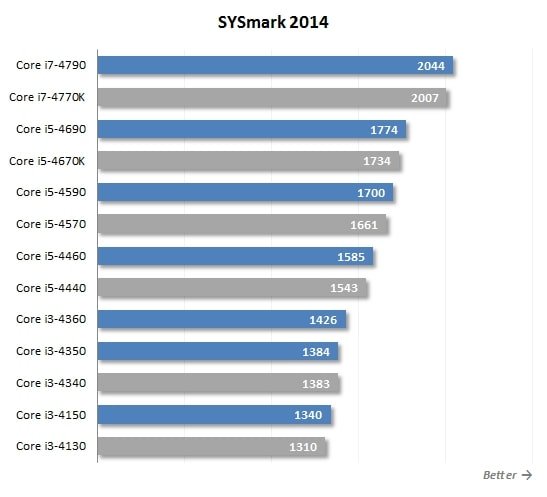
These results might be expected. The Haswell Refresh processors have no improvements or optimizations in their microarchitecture, so the only difference from the older Haswell CPUs is due to clock rate. The new CPUs have a 100 MHz higher clock rate, which ensures an average 2.5% performance gain. To be specific, the Core i7-4790 is 1.8% ahead of the Core i7-4771 (also known as Core i7-4770K). The Core i5-4690 is 2.3% faster than the Core i5-4670. The Core i5-4590 is 2.3% faster than the Core i5-4570. The Core i5-4460 is 2.7% ahead of the Core i5-4440. The Core i3-4360 is 3.1% ahead of the Core i3-4340. And the Core i3-4150 is 2.3% faster than the Core i3-4130.
Now let’s take a closer look at the performance scores SYSmark 2014 generates in different usage scenarios. The Office Productivity scenario emulates typical office tasks, such as text editing, spreadsheets, email and web-surfing. This scenario uses the following applications: Adobe Acrobat XI Pro, Google Chrome 32, Microsoft Excel 2013, Microsoft OneNote 2013, Microsoft Outlook 2013, Microsoft PowerPoint 2013, Microsoft Word 2013, and WinZip Pro 17.5.
Now let’s take a closer look at the performance scores SYSmark 2014 generates in different usage scenarios. The Office Productivity scenario emulates typical office tasks, such as text editing, spreadsheets, email and web-surfing. This scenario uses the following applications: Adobe Acrobat XI Pro, Google Chrome 32, Microsoft Excel 2013, Microsoft OneNote 2013, Microsoft Outlook 2013, Microsoft PowerPoint 2013, Microsoft Word 2013, and WinZip Pro 17.5.
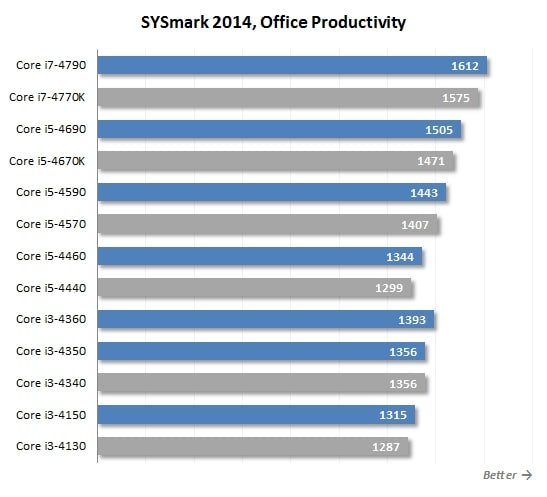
The Media Creation scenario emulates the creation of a video clip out of prepared materials (digital images and videos) using Adobe Photoshop CS6 Extended, Adobe Premiere Pro CS6 и Trimble SketchUp Pro 2013.
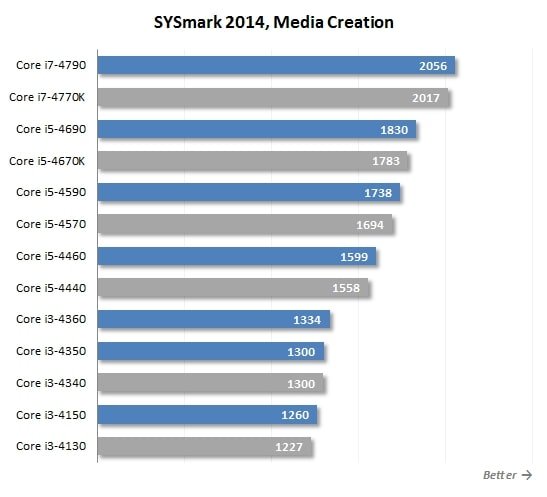
The Data/Financial Analysis scenario is devoted to statistical and market analysis. It processes a lot of numerical data in two applications: Microsoft Excel 2013 and WinZip Pro 17.5.
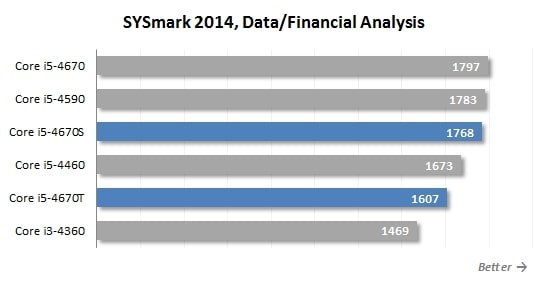
Gaming Performance
As you know, it is the graphics subsystem that determines the performance of the entire platform in the majority of contemporary games if the platform has a fast enough processor. Therefore, we select the most CPU-dependent games and measure the frame rate in two test modes. For the first mode we use lower resolutions and disable full-screen antialiasing, so we could see how well the processor can cope with gaming loads in general. This provides some insight into how the tested CPU is going to behave in the nearest future when it is accompanied with faster graphics cards. The second test mode refers to real-life settings: Full HD and maximum FSAA. In our opinion, these results are no less interesting as they demonstrate clearly the level of performance we can expect from contemporary processors today.
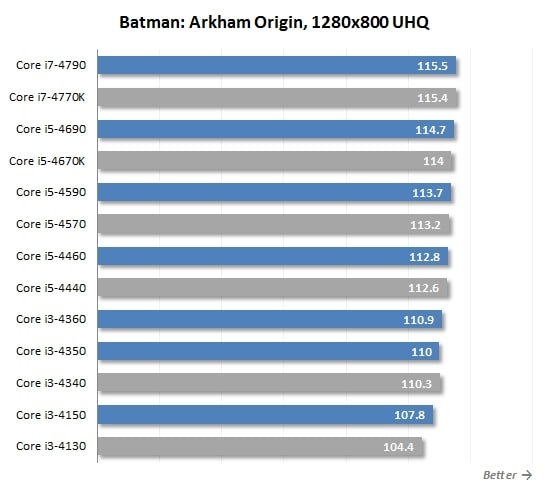
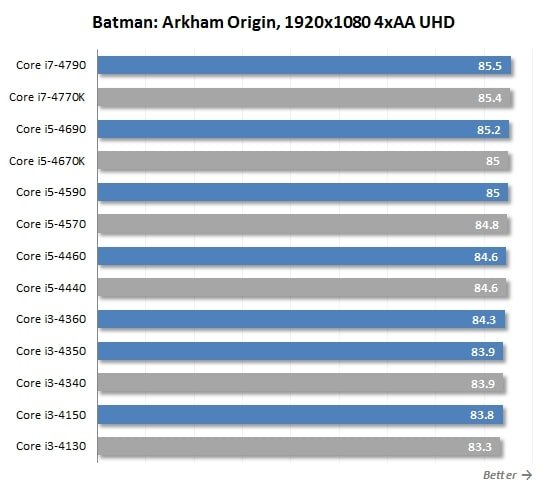
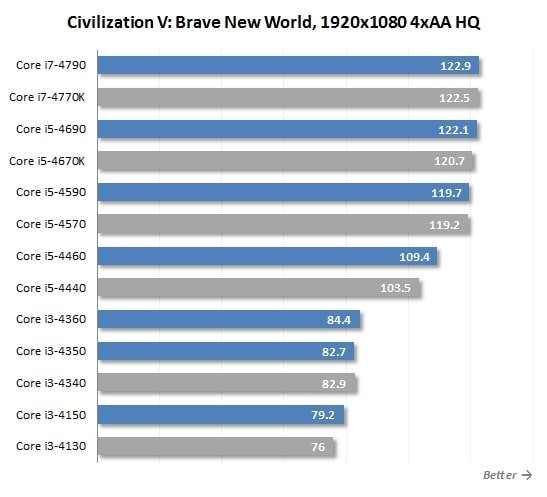
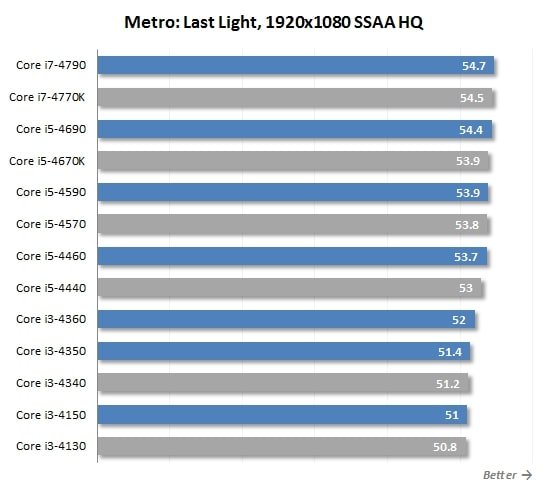
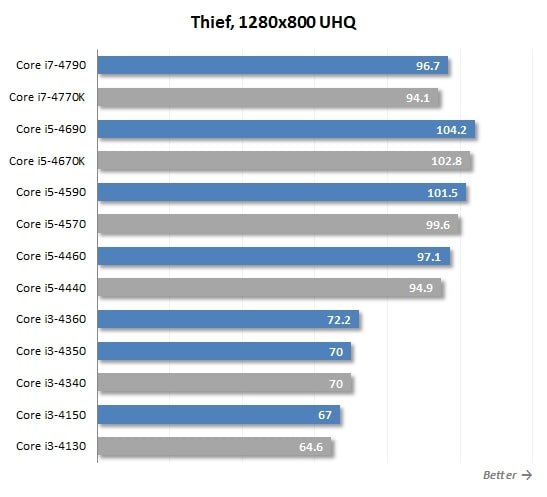
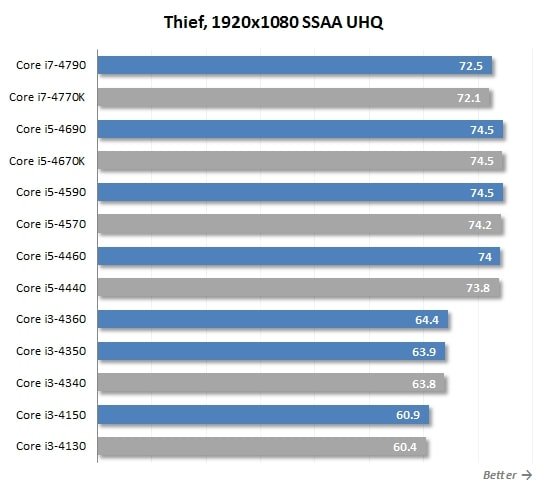
We don’t have many tests here because the performance benefits of the Haswell Refresh series are not substantial. Anyway, we can gather some information from the diagrams.
Any Intel CPU is fast enough in Batman: Arkham Origin to accompany the flagship discrete graphics card Nvidia GeForce GTX 780 Ti. The CPU has little effect on the frame rate, and the new Haswell Refresh CPUs are no different from the older products.
Civilization V: Brave New World is a strategy game that uses the CPU for lots of calculations, but doesn’t really call for a powerful CPU. Starting from the i5-4570 upwards, there is almost no performance growth. Below that mark, the Haswell Refresh products are up to 3% faster than their predecessors.
Metro: Last Light is a CPU-dependent shooter, yet its frame rate is still limited by the graphics core at the highest visual quality settings (largely due to tessellation). It is only when we reduce the display resolution that we can see a 2% advantage of the Haswell Refresh processors.
Thief is one of the few games that don’t like Hyper-Threading in quad-core processors. It is optimized for four threads, so the additional virtual cores of the Core i7 CPUs slow it down. The Haswell Refresh series is up to 3% and 1% faster than the regular Haswell at the lower and higher resolutions, respectively.
Application Tests
In Autodesk 3ds max 2014 we benchmark the speed of mental ray rendering of a complex 3D scene.
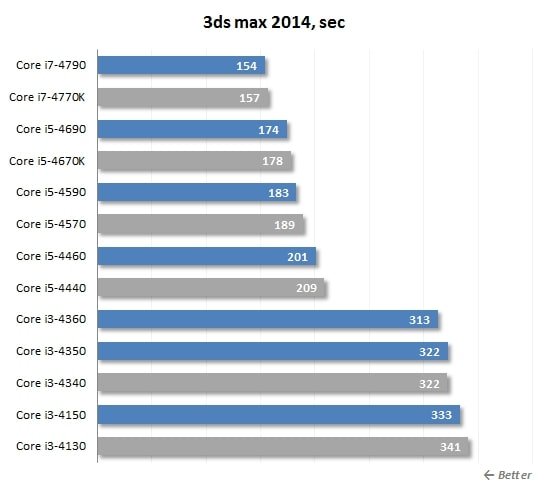
The performance in Adobe Premiere Pro CC is measured as the time it takes to render a Blu-ray project with HDV 1080p25 video into H.264 format and apply special effects to it.
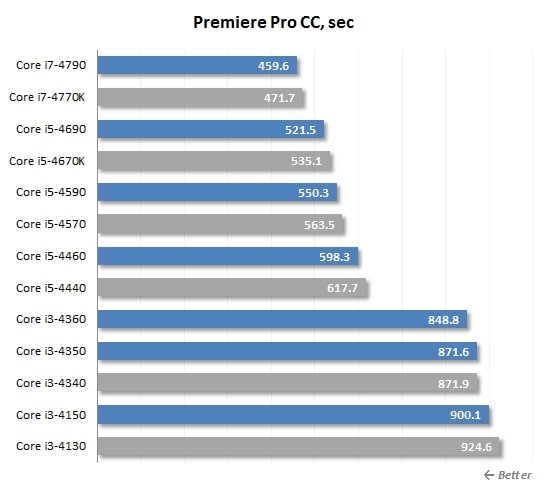
We benchmark performance in Adobe Photoshop CC using our custom test that is based on the Retouch Artists Photoshop Speed Test and consists of typical processing of four 24-megapixel images captured with a digital camera.
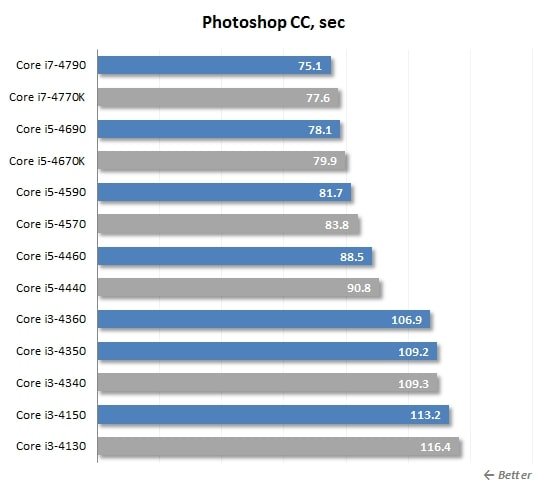
To test the processors’ performance at data archiving we launch WinRAR 5.0. Using maximum compression rate, we archive a 1.7GB folder with multiple files.
In order to measure how fast the tested CPUs can transcode video into H.264 format we used x264 FHD Benchmark 1.0.1 (64 bit). It measures the time it takes the x264 coder to convert an MPEG-4/AVC video recorded in 1920×1080@50fps resolution with default settings. The results have high practical value because the x264 codec is part of popular transcoding utilities such as HandBrake, MeGUI, VirtualDub, etc. We regularly update the coder used in this performance test. This time around, we use version r2431 which supports all contemporary instruction sets including AVX2.
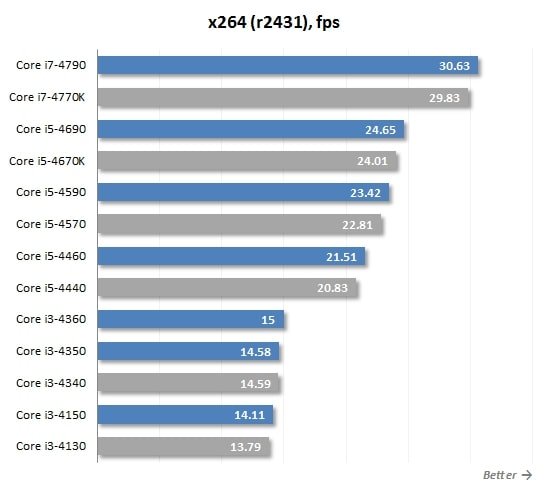
None of our tests reveals any significant advantages of the Haswell Refresh processors over their predecessors. It might be expected considering that the only difference of the new CPUs is their higher clock rate. There is no other source for performance breakthroughs. Thus, the Core i7-4790, Core i5-4690, Core i5-4590, Core i5-4460, Core i3-4360, Core i3-4350 and Core i3-4150 are no more than 3% faster than their respective predecessors.
Power Consumption
The performance benefits provided by the Haswell Refresh series do not impress us. Still, they might be better than their predecessors in terms of thermal or electrical properties due to improvements in their manufacturing technology. Let’s check this out.
The graphs below (unless specified otherwise) show the full power draw of the computer (without the monitor) from the wall socket. It is the total power consumption of all system components. The PSU’s efficiency is taken into account but our Corsair AX760i is a highly efficient 80 PLUS Platinum product, so its effect on the result is very small. We enable Turbo technology and all power-saving technologies: C1E, C6 and Enhanced Intel SpeedStep.
First we test our PC configurations in idle mode.
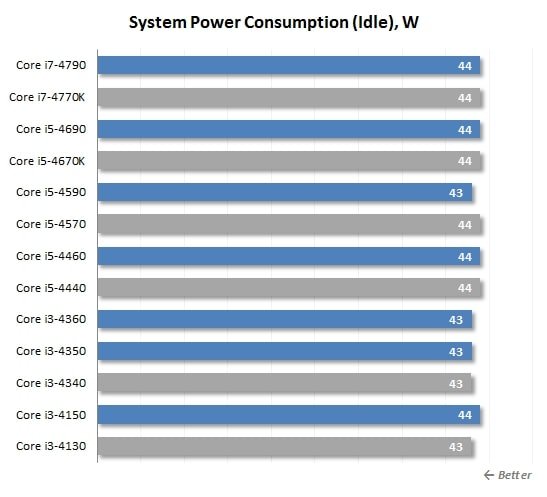
All of the processors have the same results here. The Haswell switches into a power-saving state when idle, minimizing its power consumption to zero. So the numbers in the diagram are rather indicative of the power draw of the rest of the configuration.
Next we measure the peak power consumption when our configurations run the 64-bit version of the LinX 0.6.5 utility (based on the Linpack suite) with support for the AVX2 instruction set.
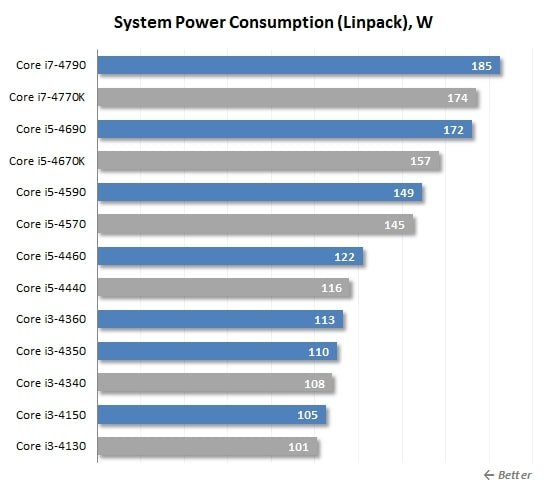
The diagram makes it clear that the Haswell Refresh processors are no improvement in terms of power consumption. The new and faster models need more power than their predecessors. The 100MHz increase in clock rate results in a 5% increase in power consumption. Despite this fact, Intel doesn’t change the TDP, so the heat dissipation of any Core i7 and i5 must be within 84 watts. The Core i3 series is supposed to consume no more than 54 watts.
The Linpack-based LinX utility makes the processor consume much more power than at average real-life loads, so we will have a more realistic test as well. We will transcode a video clip using the 64-bit x264 codec version r2431.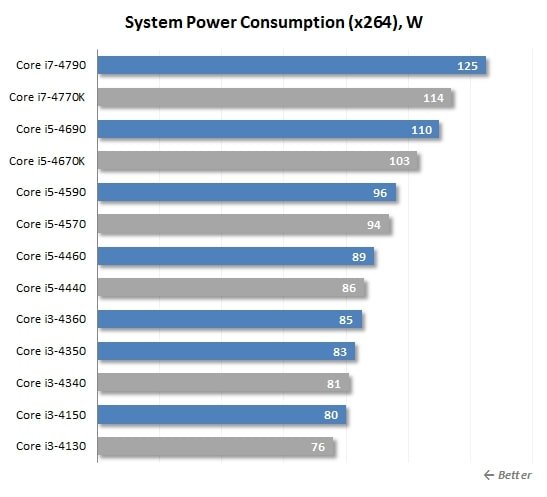
The overall picture is the same as in the LinX test but the numbers are lower. Anyway, the Haswell Refresh processors consume 5% more than their predecessors. There seem to be no improvements in terms of power consumption.
As for temperature, the Haswell Refresh processors have the same low-efficiency thermal interface as before. Their temperature rises sharply as soon as you launch a heavy application and remains high even if you’ve got an efficient CPU cooler. In our case, with the Noctua NH-U14S cooler, the senior Haswell Refresh model, Core i7-4790, quickly got as hot as 84°C while running LinX – without any overclocking on our part!

We can remind you that Haswell-based processors enable thermal throttling at 100°C.
Conclusion
The Haswell Refresh brand covers ordinary enough processors that don’t have anything new to offer to the public. Intel didn’t do any engineering work with them, so the consumer properties of the new LGA1150 CPUs are the same as before including the number of x86 cores, the amount of cache memory, the type of the integrated graphics core, and the supported technologies. There are no optimizations in the semiconductor die, so the Haswell Refresh is identical to the Haswell in terms of power consumption and heat dissipation, too.
The only real improvement is about the clock rate but it is only achieved by overclocking old processors. It is increased by 100 MHz only, so the performance benefits are very small. The new Haswell Refresh processors are a mere 2-3% faster than their Haswell predecessors in our tests.
Thus, Haswell Refresh CPUs may only be interesting for users who buy their first LGA1150 computer. The new CPUs come at the same prices as the old ones, so it makes sense to prefer them and get slightly higher performance for the same money.
Moreover, two more Haswell Refresh products are going to be revealed in the next few weeks. These are the overclocker-friendly Core i7-4790K and Core i5-4690K. Codenamed Devil’s Canyon, they will feature much higher clock rates, lower operating temperature and better overclocking potential. We will test them as soon as they come out.